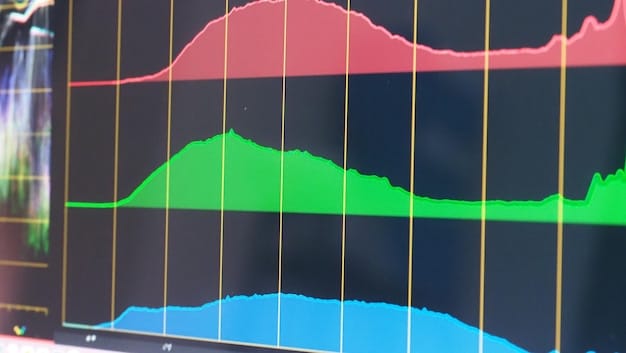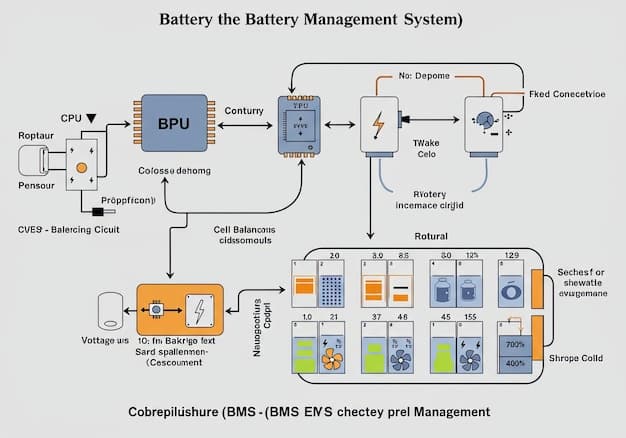Unlock Grid Services Revenue: US Energy Storage Owners & Frequency Regulation in 2025

Unlocking grid services revenue for US energy storage owners in 2025 hinges on effectively participating in frequency regulation markets, which requires understanding market structures, regulatory landscapes, and optimizing energy storage systems for rapid response and accurate performance.
Are you an energy storage owner in the US looking to maximize your profits in 2025? The key lies in understanding and leveraging grid services, particularly frequency regulation. This article will guide you through the opportunities and strategies to unlock substantial revenue streams.
Understanding Frequency Regulation and its Market Potential
Frequency regulation is a critical grid service that ensures the balance between electricity supply and demand. It involves rapidly adjusting power output to maintain the grid’s frequency at a stable level, typically 60 Hz in the US. Energy storage systems, with their quick response times, are ideally suited for providing this service, offering a lucrative revenue stream for owners.
The market potential for frequency regulation in the US is substantial and growing. As renewable energy sources like solar and wind become more prevalent, the need for frequency regulation increases due to the inherent variability of these sources. Energy storage systems can fill this gap, providing a reliable and responsive solution.
The Role of Energy Storage in Frequency Regulation
Energy storage systems, particularly battery energy storage systems (BESS), excel at frequency regulation due to their ability to quickly absorb and release power. This rapid response is crucial for maintaining grid stability. Unlike traditional generators, energy storage can react to fluctuations in milliseconds, making them highly effective in managing frequency.
By participating in frequency regulation markets, energy storage owners can earn revenue by providing this essential service. The revenue is typically based on the capacity provided and the performance of the system in responding to frequency signals.
- Rapid response times of battery energy storage systems (BESS) enable quick absorption and release of power.
- Effective management of frequency fluctuations is crucial for grid stability.
- Participation in frequency regulation markets allows energy storage owners to earn revenue.
Frequency regulation markets are evolving, and understanding the nuances of these markets is essential for maximizing profitability. Market structures vary across different regions in the US, and regulatory policies can significantly impact revenue potential. Therefore, staying informed and adapting to changes is critical for success.
Navigating US Frequency Regulation Markets
The US has several frequency regulation markets, each with its own rules, pricing mechanisms, and opportunities. Independent System Operators (ISOs) and Regional Transmission Organizations (RTOs) manage these markets, and understanding their specific requirements is crucial for energy storage owners looking to participate.
Different ISOs and RTOs compensate frequency regulation services differently. Some use a pay-for-performance model, where revenue is based on how accurately the energy storage system responds to frequency signals. Others use a capacity-based model, where revenue is based on the amount of capacity the system provides.
Key US Frequency Regulation Markets
Some of the key frequency regulation markets in the US include PJM, CAISO, NYISO, and ERCOT. Each of these markets has its own unique characteristics and opportunities for energy storage owners. Understanding these differences is essential for developing a successful market participation strategy.
PJM, for example, is one of the largest and most mature frequency regulation markets in the US. It uses a pay-for-performance model and offers significant revenue potential for energy storage owners who can accurately respond to frequency signals. CAISO, on the other hand, is focused on integrating renewable energy and has a growing need for frequency regulation services.
- PJM is one of the largest and most mature frequency regulation markets in the US.
- CAISO is focused on integrating renewable energy and has a growing need for frequency regulation services.
- NYISO and ERCOT also offer unique opportunities for energy storage owners.
Participating in frequency regulation markets requires careful planning and optimization. Energy storage owners need to consider factors such as system size, location, and performance capabilities to maximize their revenue potential. Additionally, understanding the bidding process and market rules is crucial for success.
In summary, navigating the US frequency regulation markets requires a deep understanding of the specific rules and opportunities in each region. By tailoring their strategies to the unique characteristics of each market, energy storage owners can unlock significant revenue streams and contribute to grid stability.

Regulatory and Policy Landscape for Energy Storage
The regulatory and policy landscape plays a crucial role in shaping the opportunities for energy storage in frequency regulation. Federal and state policies can significantly impact the economics of energy storage projects and their ability to participate in grid services markets. Understanding these policies is essential for energy storage owners.
Federal policies, such as the Federal Energy Regulatory Commission (FERC) Order 841, have been instrumental in promoting energy storage participation in wholesale markets. This order requires ISOs and RTOs to remove barriers to energy storage participation, creating new opportunities for revenue generation.
Impact of Federal and State Policies
State policies also play a significant role in driving energy storage deployment and market participation. Many states have established energy storage targets, incentives, and regulatory frameworks that support the growth of the industry. These policies can provide financial incentives and create a more favorable environment for energy storage projects.
For example, California has a leading energy storage mandate and offers various incentives for energy storage projects. Other states, such as New York and Massachusetts, have also implemented policies to encourage energy storage deployment. These policies can significantly improve the economics of energy storage projects and make them more attractive investments.
- FERC Order 841 promotes energy storage participation in wholesale markets.
- State policies provide financial incentives and support the growth of the industry.
- California, New York, and Massachusetts have leading energy storage mandates and incentives.
Navigating the regulatory landscape requires staying informed about policy changes and engaging with regulatory bodies. Energy storage owners should actively participate in regulatory proceedings and advocate for policies that support the growth of the industry. By staying engaged and informed, energy storage owners can help shape the future of energy storage and unlock new revenue opportunities.
In conclusion, the regulatory and policy landscape is a critical factor in determining the success of energy storage projects in frequency regulation. By understanding and engaging with these policies, energy storage owners can maximize their revenue potential and contribute to a more sustainable energy future.
Optimizing Energy Storage Systems for Frequency Regulation
To effectively participate in frequency regulation markets, energy storage systems need to be optimized for rapid response, accurate performance, and efficient operation. This involves selecting the right technology, configuring the system properly, and implementing advanced control strategies.
The choice of energy storage technology is a critical factor in determining performance in frequency regulation. Battery energy storage systems (BESS) are generally the preferred technology due to their rapid response times and high efficiency. However, other technologies, such as flywheels and pumped hydro storage, can also be used in certain applications.
Key Considerations for Optimization
System configuration is another important consideration. Energy storage systems need to be sized and configured properly to meet the specific requirements of the frequency regulation market. This includes considering factors such as capacity, power rating, and response time.
Advanced control strategies are essential for optimizing performance in frequency regulation. These strategies involve using sophisticated algorithms to control the charging and discharging of the energy storage system in response to frequency signals. Effective control strategies can improve accuracy, reduce wear and tear, and maximize revenue.

- Choose the right energy storage technology, such as battery energy storage systems (BESS).
- Size and configure the system properly to meet market requirements.
- Implement advanced control strategies to optimize performance.
Regular monitoring and maintenance are also critical for ensuring optimal performance. Energy storage systems should be monitored continuously to detect any issues and prevent downtime. Regular maintenance can help extend the lifespan of the system and maintain its performance capabilities.
In summary, optimizing energy storage systems for frequency regulation requires careful planning, selection of the right technology, proper configuration, advanced control strategies, and regular monitoring and maintenance. By focusing on these key areas, energy storage owners can maximize their revenue potential and contribute to grid stability.
Financial Modeling and Investment Strategies
Developing a robust financial model is essential for assessing the economic viability of energy storage projects participating in frequency regulation. A well-constructed model can help investors understand the potential revenue, costs, and risks associated with these projects.
Financial models for energy storage projects should consider factors such as capital costs, operating expenses, revenue from frequency regulation, and potential degradation of the energy storage system over time. These models can help investors determine the optimal system size and configuration for maximizing returns.
Key Elements of a Financial Model
Investment strategies for energy storage in frequency regulation should be tailored to the specific characteristics of the project and the investor’s risk tolerance. Some investors may prefer to own and operate the energy storage system themselves, while others may prefer to partner with a third-party developer or operator.
Securing financing for energy storage projects can be challenging, but various options are available. These include debt financing, equity financing, and government grants and incentives. Energy storage owners should explore all available options to find the most cost-effective financing solution.
- Develop a robust financial model to assess economic viability.
- Tailor investment strategies to project characteristics and risk tolerance.
- Explore various financing options, including debt, equity, and government incentives.
Risk management is also a critical component of financial modeling and investment strategies. Energy storage projects are subject to various risks, including technology risk, market risk, and regulatory risk. Investors should carefully assess these risks and develop strategies to mitigate them.
In conclusion, financial modeling and investment strategies are essential for the success of energy storage projects participating in frequency regulation. By developing a robust financial model, tailoring investment strategies to project characteristics, and effectively managing risks, investors can maximize their returns and contribute to a more sustainable energy future.
Future Trends and Opportunities in Frequency Regulation
The future of frequency regulation is likely to be shaped by several key trends, including the increasing penetration of renewable energy, the development of advanced energy storage technologies, and the evolution of market structures and regulatory policies. Understanding these trends is essential for energy storage owners looking to capitalize on future opportunities.
As renewable energy sources like solar and wind continue to grow, the need for frequency regulation will increase. The intermittent nature of these sources creates challenges for grid stability, and energy storage systems will play a critical role in managing these fluctuations.
Emerging Technologies and Market Developments
Advanced energy storage technologies are also likely to play a key role in the future of frequency regulation. New battery chemistries, such as solid-state batteries and lithium-sulfur batteries, offer the potential for higher energy density, longer lifespan, and lower costs. These technologies could significantly improve the economics of energy storage projects and expand their applications in frequency regulation.
Market structures and regulatory policies are also expected to evolve in the coming years. ISOs and RTOs are exploring new ways to compensate frequency regulation services and to integrate energy storage into their markets. Regulatory policies are also likely to become more supportive of energy storage deployment, creating new opportunities for revenue generation.
- Increasing penetration of renewable energy will drive the need for frequency regulation.
- Advanced energy storage technologies offer the potential for higher performance and lower costs.
- Market structures and regulatory policies are expected to evolve to support energy storage.
The convergence of these trends presents significant opportunities for energy storage owners. By staying informed about market developments, investing in advanced technologies, and engaging with regulatory bodies, energy storage owners can position themselves to capitalize on the future of frequency regulation.
In summary, the future of frequency regulation is bright, with numerous opportunities for energy storage owners. By understanding the key trends and positioning themselves to take advantage of these opportunities, energy storage owners can unlock substantial revenue streams and contribute to a more sustainable energy future.
| Key Point | Brief Description |
|---|---|
| ⚡ Frequency Regulation | Maintaining grid stability by balancing electricity supply and demand. |
| 💰 Revenue Streams | Energy storage owners can earn by providing frequency regulation services. |
| ⚖️ Regulatory Landscape | Understanding federal and state policies is crucial for market participation. |
| 🔋 Optimization | Optimizing energy storage systems for rapid response and accurate performance. |
FAQ – Frequently Asked Questions
What is frequency regulation?
▼
Frequency regulation is a grid service that balances electricity supply and demand to maintain a stable frequency on the grid, typically around 60 Hz in the US.
What role does energy storage play in frequency regulation?
▼
Energy storage systems, like batteries, can quickly absorb or release electricity, making them ideal for responding to frequency changes and maintaining grid stability.
How can energy storage owners profit from frequency regulation?
▼
Energy storage owners can participate in frequency regulation markets and get paid for providing the service of stabilizing grid frequency.
What are the key frequency regulation markets in the US?
▼
Key markets include PJM, CAISO, NYISO, and ERCOT, each with its rules and opportunities for energy storage participation.
What policies support energy storage in frequency regulation?
▼
FERC Order 841 and state-level incentives encourage energy storage deployment and participation in wholesale markets, including frequency regulation services.
Conclusion
Unlocking grid services revenue through frequency regulation presents a significant opportunity for US energy storage owners in 2025. By understanding market dynamics, optimizing system performance, and navigating the regulatory landscape, energy storage owners can tap into lucrative revenue streams and contribute to a more resilient and sustainable grid.





